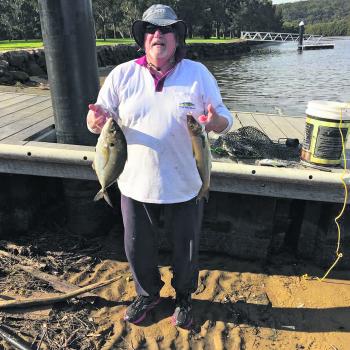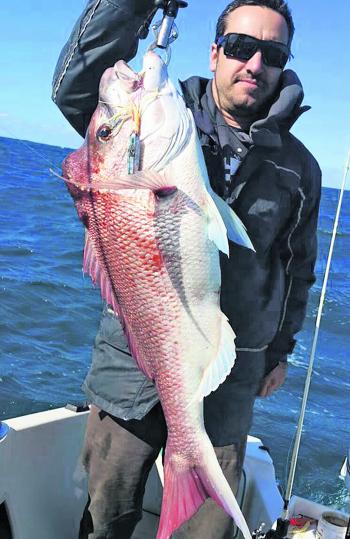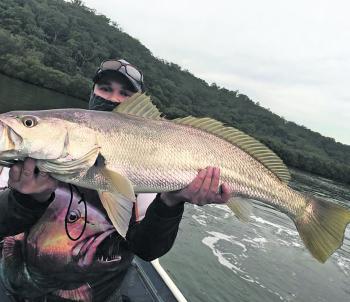It never ceases to amaze me how fishing can change so quickly. In the past edition of Fishing Monthly, we mentioned how the Moons in the upper reaches of the Georges River were fishing well for whiting and bream. The fish have all but disappeared now; you would be lucky to pluck one or two.
Could it be the jet skiers that descend on the area in droves and stop the fish from biting? Possibly. It’s not uncommon to see many PWCs reaching speeds of up to 60km/h in an 8 knot zone, and it’s only a matter of time before there’s a fatality. Something has to be done, as it is impossible to fish the river on weekends.
Oatley Bay Boat Ramp is still closed for refurbishing and won’t open until sometime in October – if we’re lucky. I recently had a look at how it was going, and it looks fine, but I’m no project engineer. For now, we’ll have to put up with increased congestion on other boat ramps in the area. I will keep you readers posted on its progress.
Fishing in the Georges River has been very ordinary in recent weeks, with a lot of effort needed to catch a feed of whiting and bream. I found the stretch of water between Jewfish Point and the old Lugarno Ferry hotspot to be the most consistent.
This area is known as Cranbrook, and it’s gained a reputation as a luderick hotspot, with outstanding catches to its credit. Situated upriver from Como Ridge, the oyster leases which used to abound there are now gone, but remnants can easily be seen on the low tides, with white markers still showing.
All along this area is top breaming country, particularly at this time of year where schools of bream tend to filter towards the upper reaches of the system. Both the last of the run-in tide and the first of the falling tide are favoured, and the technique is to cast your bait on the edge of the channel and let the flow of water move it along the bottom. Many luderick have come to grief from this position, especially along the old retaining wall on the eastern side.
I’ve been averaging a dozen good bream to 35cm per session using live bloodworms and a long trace of 1.5m+ between the sinker and hook. This allows the bait to move around, and allows the fish to bite more readily. The prawn berley distributed by Premier Coast is dynamite, and saves you the trouble of preparing your own berley mixture.
Elsewhere in the river, small bream between 23-25cm are driving anglers mad, taking baits meant for larger predators. I don’t know how to get away from these pests. Probably the best method would be to fish in shallower water, or stick to night time fishing.
Luderick have been the mainstay in the Woronora River. A recent competition by the ‘Wonnie’ Fishing Club yielded quite good numbers, with the larger fish nudging the 1kg mark whole. The old house at the entrance to this system on the western side has been productive during the run-out tide. The best way to position your boat is to use two anchors, which allows you to fish side-on to the current. Bream are also common when berley is applied around dusk.
Bonnet Head has been fishing well for the same species, and is a handy location to get away from bad weather and fish in relatively comfortable conditions. The well-maintained Bonnet Bay is only a short distance away.
If you’ve got the kids with you and you’re looking for a spot that’s safe and easy to get to, look no further than Jannali Reserve. This is a great land-based spot which can always be relied upon to provide a few fish. I’ve heard of good flatties taken from the western shoreline just upstream of the foot bridge adjacent to Neales Inlet, with Squidgy Pro Fish in grasshopper doing the most damage.
Good size tailor have been filtering through the system, and a few to 60cm have been taken at night, shore-based on whole pilchards. A similar story applies between Captain Cook Bridge and the channel marker at the entrance to Woolooware Bay, where 20cm Raiders in blue and green mackerel patterns have accounted for good tailor.
Bobby Dean, one of the most accomplished anglers on the river, has been catching good mulloway land-based at Picnic Point. Bob only fishes the tide change period and uses only live bloodworms. Some of his catches are quite remarkable, but you need to get out of bed at all hours to get results like his.
Oatley Bay has been very quiet, with not too many anglers trying the area. This is customary for the area at this time of year, but it will improve over the next few months.
I witnessed a few tailor taken from the north side of Tom Uglys Bridge and the odd flathead failing for pilchard cubes.
The bay itself is not setting the world on fire. Kingfish in the 65-70cm range have shown up wide of Molineaux Point and have been taking very fresh strips of squid during the early hours, while the Bare Island area has also showed signs of better class fish. A whole squid downrigged between Cape Banks, Shaky and Julienne is a sure bet if you’re looking for that trophy king, but you must know what you’re doing or there’s no hope.
Flathead have been on the prowl between Nowra Point and Ramsgate Baths. Norm and Dave are probably the best flatty fishers in the area, and they have been getting their bag limits consistently with lizards between 40-50cm. Norm takes the easy way out by casting his Gary Glitter Squidgy ahead, then placing his rod in the holder allowing the fish to hook itself. Similar catches have been reported from the Yarra Bay drift and the Sutherland Point to Little Yewa stretch.
There are a few leather jacket around, with the Port Botany retaining wall and the artificial reefs great starting points. Berley is essential, and a paternoster rig armed with a size 8 long shank hook is all you need. A sinker to suit the conditions and a piece of squid or peeled prawn pinched on the hook will do the job.
If you’re fishing the rocks, Little Bay has been absolutely fantastic, with luderick, drummer, trevally and kings filling the creek. We’ve had word of some catches of 50+ fish in the area, with one of the kings exceeding 15kg.
Henrys Head, just inside Botany Bay, is another rock possie that has been delivering the goods. The main fishing area here is a well-defined ledge at the very tip of the point, ad is easily accessible by walking past the NSW gold course club house down to Endeavour Lighthouse. Good groper, drummer, luderick, leatherjacket and a few good snapper have been taken there the last few weeks along with tailor and salmon.
Cooks River hasn’t been too bad with trevally, tailor and whiting taken in fair numbers, but the boat traffic is a constant pain, so it may be better to leave your fishing until during the week, especially if you’ve got an early morning run out tide or at night on the run in tide.
The offshore scene has been a hit-and-miss affair. Big gemfish have been taken at Browns Mountain in good numbers, but lack of blue-eye trevalla has made the long trip to the mountain a costly exercise. It’s a similar story at the 12 mile reef where school kingfish have been boated. I’m told the big Chinaman jackets are back in numbers, while the longfin perch are sitting right on the pinnacles. The peak has trevally by the bucketload, and provides excellent sport for the new chum fishos as well as providing an excellent feed if smoked in hickory dust.
Flathead have been the mainstay, with most recognised grounds producing good blue-spot lizards. The charter boat Bianca bagged out on the flatties fishing the Falls and Garie Beach.
Other locations which can be relied on to provide a feed include the middle ground at the entrance to Port Hacking, wide off Boat Harbour, Mistral Point, Maroubra Wide and the ever-reliable 40m drift between Botany Heads.
October is a great month for mulloway, and I expect the first run of schoolies to be evident around Captain Cook Bridge, Tom Uglys Bridge and Como Bridge. Your best bet is to fish two days before the full moon period, with slack water the best time. We should see a few soapy-size fish around the oil wharf at Kurnell, and the fishing will only get better as the season progresses. Bare Island traditionally is an excellent spot for most species, so expect good catches.
Bream will make the annual run in the Georges, and upstream of Como Bridge will be the place to look for them. I expect them to start feeding on the weed patches close to sand banks, slowly pushing the whiting out into deeper waters. Although it’s a bit early, I expect a few good fish will be taken around Elephants Trunk, Caster Island and Pelican Point.
Luderick catches should decline as the water in the estuaries tend to warm up, but they can still be taken around bridge pylons and will be considerably larger than the ones caught in winter.
We can expect whiting to show up in good numbers this month. I believe that, pound- for-pound, whiting is one of out finest fishing fish, especially on ultra light gear. You’ll find them on the Cornwells at Cockle Bed, the crack in the wall at Oatley Bay, the Caravan Head Channel, the entrance to the Woronora River, Cranbrook and Black Butt wide.
Estuary perch and bass will be available above Needles and Shackles Estate in the Woronora River, Liverpool Weir, the stretch close to Cambridge West Weir, and Cabramatta and Prospect Creeks, with worms the best bait available.
If you fancy a bit of travelling, Sydney’s best kept secret is out. The Nepean River, Cobbity Weir, Menangle Weir, Douglas Park, Ellis Lane and Theresa Park are all holding good numbers of bass.
Come and see me at the shop in Narellan for the latest info. I’ll be giving a talk on how to catch big whiting on Wednesday evening, November 2 at the St George and Sutherland Shire Fishermen Club. If you would like to learn to catch that 1kg+ fish, come and talk to me. Tight lines!
Reads: 4243
The author’s 45cm trevally and whiting amongst a catch of 15 whiting, three bream and a trevally caught at the Moons with Ted Vlores.

Luke's recent catch off Sydney.

This 95cm snapper is still out there after being released by Chicken Pete.

A beautiful mulloway caught in the Georges River.




